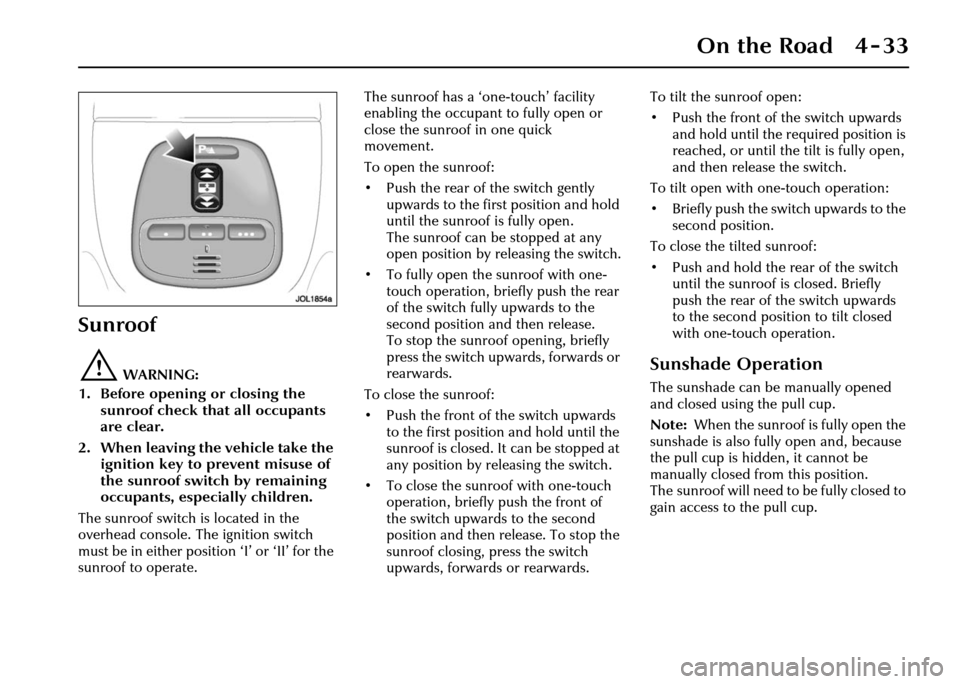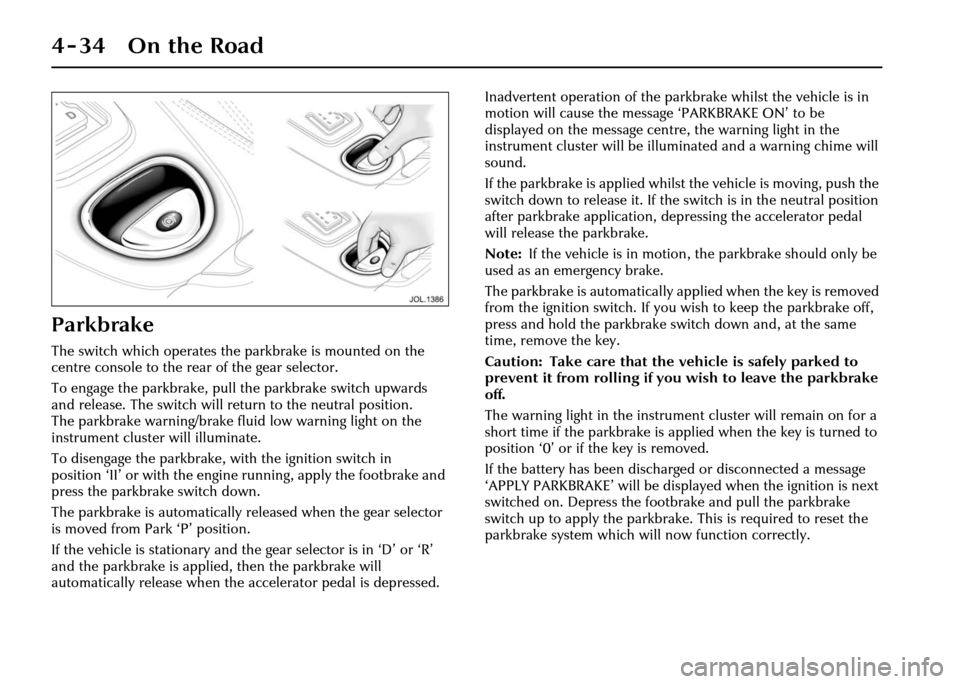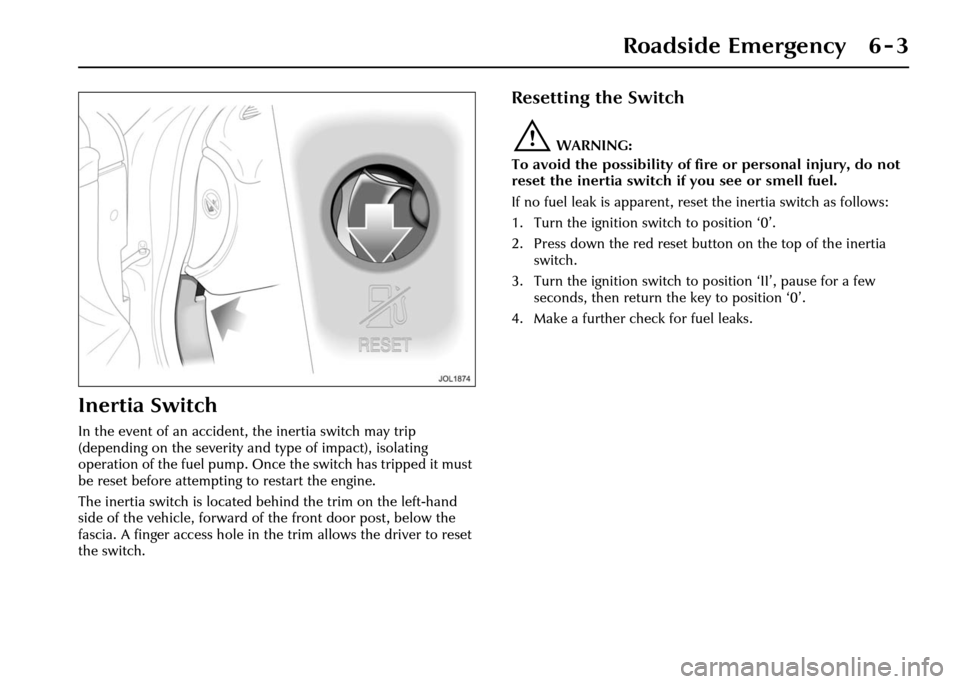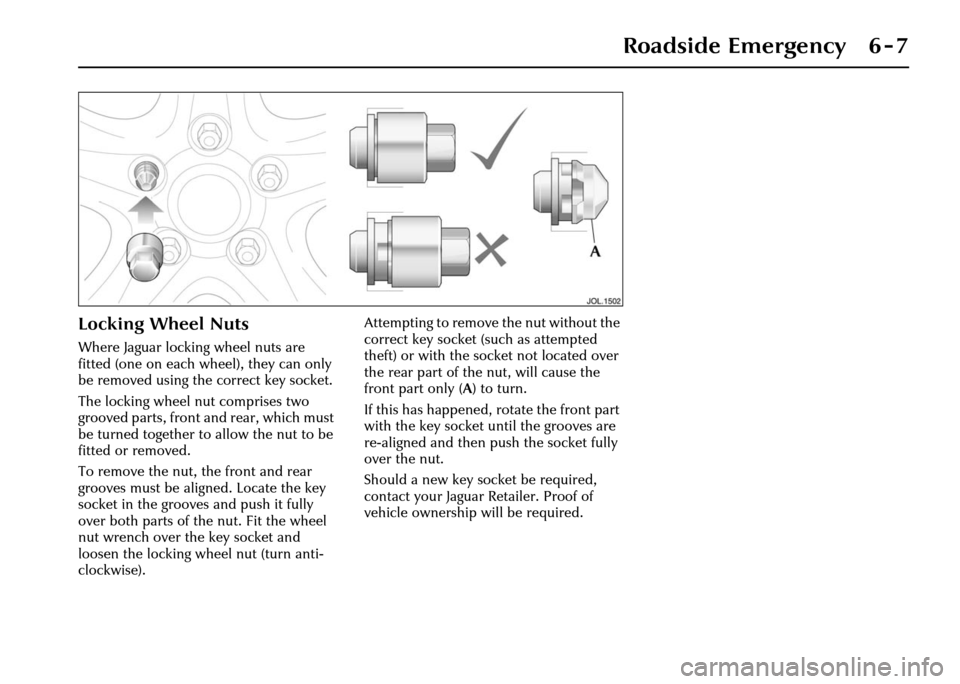Key JAGUAR XJ 2004 X350 / 3.G Owner's Guide
[x] Cancel search | Manufacturer: JAGUAR, Model Year: 2004, Model line: XJ, Model: JAGUAR XJ 2004 X350 / 3.GPages: 227, PDF Size: 4.22 MB
Page 100 of 227

On the Road 4 - 29
Window Operation
The front and rear door windows are
electrically operated by switches located
on each door.
Switches on the driver’s door control all
door windows.
Passengers are provided with a switch to
control their door window only.
These switches will only operate the
windows when the ignition switch is in
position ‘I’ or ‘II’.
Button (A) immobilises operation of the
rear windows (and front seat adjustment,
when fitted) by rear seat occupants.
!WARNING:
1. When raising windows ensure all occupants are clear.
2. When leaving the vehicle take the ignition keys to prevent misuse of
the window switches by
remaining occupants, especially
children.
Raise/lower
Each switch has two positions to raise the
window and two positions to lower the
window.
To lower a window, press the switch
downwards to the first position until the
desired window position is reached, then
release.
To raise a window, pull the switch
upwards to the first position until the
desired position is re ached, then release.
If the switches are held for longer than
6 seconds, for example, when attempting
to overcome frozen or jammed windows,
the window drive will be switched off for
a few seconds to protect the window
drive motors. The windows can be operated with the
key removed from the ignition switch
within 10 minutes of the vehicle being
stopped provided the driver’s or front
passenger’s door has not been opened.
If a rear door is opened the windows can
still be operated within the 10 minute
period.
One-touch operation
Each window has a ‘one-touch’ facility
enabling the occupant to fully open or
close the window in one quick
movement.
Press the switch briefly to the second
position to fully open the window in one
movement. Pull the swit
ch briefly to the
second position to fully close the window
in one movement. Window travel can be
stopped at any time by pressing the
switch again.
Page 104 of 227

On the Road 4 - 33
Sunroof
!WARNING:
1. Before opening or closing the sunroof check that all occupants
are clear.
2. When leaving the vehicle take the ignition key to prevent misuse of
the sunroof switch by remaining
occupants, especially children.
The sunroof switch is located in the
overhead console. The ignition switch
must be in either position ‘I’ or ‘II’ for the
sunroof to operate. The sunroof has a ‘one-touch’ facility
enabling the occupant to fully open or
close the sunroof in one quick
movement.
To open the sunroof:
• Push the rear of the switch gently
upwards to the first position and hold
until the sunroof is fully open.
The sunroof can be stopped at any
open position by releasing the switch.
• To fully open the sunroof with one- touch operation, briefly push the rear
of the switch fully upwards to the
second position and then release.
To stop the sunroof opening, briefly
press the switch upwards, forwards or
rearwards.
To close the sunroof:
• Push the front of the switch upwards to the first position and hold until the
sunroof is closed. It can be stopped at
any position by re leasing the switch.
• To close the sunroof with one-touch operation, briefly push the front of
the switch upwards to the second
position and then release. To stop the
sunroof closing, press the switch
upwards, forwards or rearwards. To tilt the sunroof open:
• Push the front of the switch upwards
and hold until the required position is
reached, or until the tilt is fully open,
and then release the switch.
To tilt open with one-touch operation:
• Briefly push the switch upwards to the second position.
To close the tilted sunroof:
• Push and hold the rear of the switch until the sunroof is closed. Briefly
push the rear of the switch upwards
to the second position to tilt closed
with one-touch operation.Sunshade Operation
The sunshade can be manually opened
and closed using the pull cup.
Note: When the sunroof is fully open the
sunshade is also fully open and, because
the pull cup is hidden, it cannot be
manually closed from this position.
The sunroof will need to be fully closed to
gain access to the pull cup.
Page 105 of 227

4-34 On the Road
Parkbrake
The switch which operates the parkbrake is mounted on the
centre console to the rear of the gear selector.
To engage the parkbrake, pull the parkbrake switch upwards
and release. The switch will return to the neutral position.
The parkbrake warning/brake fluid low warning light on the
instrument cluster will illuminate.
To disengage the parkbrake, with the ignition switch in
position ‘II’ or with the engine running, apply the footbrake and
press the parkbrake switch down.
The parkbrake is automatically released when the gear selector
is moved from Park ‘P’ position.
If the vehicle is stationary and the gear selector is in ‘D’ or ‘R’
and the parkbrake is applied, then the parkbrake will
automatically release when the accelerator pedal is depressed. Inadvertent operation of the parkbrake whilst the vehicle is in
motion will cause the message ‘PARKBRAKE ON’ to be
displayed on the message centre, the warning light in the
instrument cluster will be illuminated and a warning chime will
sound.
If the parkbrake is applied whilst
the vehicle is moving, push the
switch down to release it. If the switch is in the neutral position
after parkbrake application, depressing the accelerator pedal
will release the parkbrake.
Note: If the vehicle is in motion, the parkbrake should only be
used as an emergency brake.
The parkbrake is auto matically applied when the key is removed
from the ignition switch. If you wi sh to keep the parkbrake off,
press and hold the parkbrake switch down and, at the same
time, remove the key.
Caution: Take care that the vehicle is safely parked to
prevent it from rolling if you wish to leave the parkbrake
off.
The warning light in the instrument cluster will remain on for a
short time if the parkbrake is applied when the key is turned to
position ‘0’ or if the key is removed.
If the battery has been discharged or disconnected a message
‘APPLY PARKBRAKE’ will be displa yed when the ignition is next
switched on. Depress the footbrake and pull the parkbrake
switch up to apply the parkbrake. This is required to reset the
parkbrake system which will now function correctly.
Page 113 of 227

4-42 On the Road
Starting/Stopping the
Vehicle
When the vehicle is stationary the
automatic gear selector may be left in ‘D’,
‘ 2 ’, ‘ 3’, ‘ 4’ or ‘ 5’, unless the vehicle is to
be parked. When stopping for traffic
lights, junctions etc., either select ‘ P’ or
apply the parkbrake and select ‘ N’.
Before Starting
Before starting the engine, new owners/
drivers should familiarize themselves with
the layout and operation of the controls
and instruments.
!WARNING:
Before attempting to start the engine,
check parkbrake is ON and gear
selector lever is in position ‘P’ or ‘N’.
To Start the Engine
The engine cannot be started until the
gear selector is in ‘ N’ or ‘ P’.
Insert the key into the ignition switch and
turn clockwise to position ‘II’ to switch
on the ignition.
When the key is turned to position ‘III’
the starter motor will turn the engine
until:
• The key is released and automatically returns to position ‘II’.
• The ignition switch is turned to ‘0’ or ‘I’.
• The gear selector is moved out of ‘P’ or ‘N’.
• The engine starts.
If the engine fails to start, the key must be
turned to position ‘0’ before attempting
to restart.
Do not use the starter continuously for
longer than six seconds. Continued use of
the starter will disc harge the battery and
may damage the starter mechanism.
Wait until the engine stops turning before
re-using the starter.
When the engine starts, release the key. The red charge light and the oil pressure
light in the instrument cluster should go
out when the engine is running.
If the engine fails to start
If an ignition key is placed in the ignition
switch and turned to position ‘II’ and the
alarm security light is flashing, it is
possible that the engine will not start.
In any event, please contact a Jaguar
Retailer to investigate the cause of the
light flashing.
It is possible that the fuel system inertia
switch may have tripped, see page 6 - 3
for the resetting procedure.
If the engine persistent
ly fails to start and
flooding is suspected, depress the
accelerator pedal fully, hold it in this
position and turn the key to position ‘III’
for six seconds. Release the key, remove
your foot from the accelerator pedal and
then attempt to restart the engine.
Note: The engine cannot start whilst the
pedal is fully depressed, it must be
released to enable the engine to start.
If the engine still fail s to start, switch the
ignition OFF and contact a Jaguar
Retailer.
Page 114 of 227

On the Road 4 - 43
To Stop the Engine and Lock
the Steering
Turn the key from position ‘II’ to the
‘lock’ position ‘0’. This turns off the
ignition and stops the engine.
The steering will be locked when the key
is removed from the switch.
Leaving the key in position ‘I’ or ‘II’ will
discharge the battery.
Automatic Transmission
The ‘J’-gate gear selector lever is designed
to accommodate two different driving
techniques as follows:
• Automatic selection – the right-hand side of the selector gate.
• Manual selection – the left-hand side of the selector gate to individually
select 5th, 4th, 3rd, or 2nd gear.
Gearshift Interlock
A brake pedal/gearshift interlock system
is incorporated in the automatic gear
selector mechanism.
To move the gear selector from Park:
1. Turn the ignition key to position ‘II’ or start the engine.
2. Press the brake pedal.
3. Move the lever from Park.
Gear Selector Positions
!WARNING:
The parkbrake or brake pedal must
be applied before selecting forward
or reverse drive from a stationary
position.
P = Park – Use when parking. In this
position the transmission is locked.
Do not select if the vehicle is moving.
N = Neutral – Disconnects the driveline
from the engine. Use the parkbrake when
stopping temporarily.
Page 131 of 227

4-60 On the Road
Use of Headlamps In Daylight
When visibility is poor the headlamps
with dipped beam setting should be
switched on so that the vehicle may be
seen more easily by other road users.
The instrument illumination dimmer
control adjusts the brightness of the panel
lighting.
Engine Oil Consumption
A certain amount of oil consumption is
normal. The rate of consumption will
depend on the following:
• The quality and viscosity of the oil.
• The amount of oxidation and dilution of the oil.
• Climatic conditions.
• The speed at which the engine is being operated.
• Road conditions.
Drivers should expect above normal
consumption when the engine is new,
and after running-in if high speeds are
sustained.
Winter Driving
Freeing a frozen door lock
Caution: Do not ap ply a proprietary
lock de-icer through the keyhole.
Should the lock beco me frozen, warm the
end of the key before use.
Windscreen wiper blades
Before driving away, clear any ice from
the windscreen and check that the wiper
blades are free. Switching on the heated
screen will accelerate this process.
The heated wiper park, if fitted, will come
on automatically.
Frost precautions
The correct concentration of coolant
must be maintained at all times when
‘topping up’ or ‘refilling’ the cooling
system.
Parking the Vehicle
When leaving the vehicle, remember the
following:
• Whenever the vehicle is being parked, apply the parkbrake and move the
gear selector to Park ‘P’.
• Do not leave children or pets in the vehicle unattended.
• Do not leave luggage or valuables on view. Always take your valuables with
you or lock them in the luggage
compartment.
• Remove the ignition key and spare keys, even when the vehicle is in your
garage.
• When the vehicle is unoccupied, close
all windows and lock all doors
securely.
• Park the vehicle where it can be seen. At night, park in a well-lit area.
• Ensure that the keys and the key transmitters are removed from the
vehicle before locking the doors,
and that all doors, the luggage
compartment and the hood are
closed.
Page 134 of 227

On the Road 4 - 63
Fuel and Refuelling
Before refuelling, switch off the ignition
and remove the key.
Note:Do not leave the ignition key in the
vehicle; vehicles have been stolen from
garage service/filling stations whilst the
driver is absent from the vehicle. It is
recommended that the vehicle is locked,
if left unattended.
Caution: No additives of any kind
(fuel or oil) must be put into the fuel
tank. Additives could reduce engine
life or affect exhaust emissions.
!WARNING:
1. Fuel vapour is highly flammable and in confined spaces is
explosive and toxic. In the event
of inadvertent spillage, and before
refuelling, always switch OFF the
engine. Do not use exposed flame
or light. Do not smoke. Do not
inhale fumes.
2. Do not fill the tank so that fuel is visible in the fuel filler intake
tube. This could cause spillage
and danger from exposed fuel.
Fuel Tank Filling
Caution: Your vehicle is fitted with
catalytic converters and must only be
filled with ‘Unleaded Fuel’.
The fuel filler flap release switch is
located in the knee bolster switchpack
below the fascia. The fi ller flap is on the
right-hand side of the vehicle.
A small arrow is shown on the fuel gauge
as a reminder on which side of the
vehicle the fuel filler flap is located. Open the fuel filler flap and turn the filler
cap anti-clockwise, a ¼ turn until
resistance is felt. Continue turning to
release the cap from the filler neck.
The cap is held by a retaining strap and
can be stowed over the hook on the flap
to allow easy access to fill the tank.
A warning label on the inside of the fuel
filler flap advises type/grade of fuel.
Page 146 of 227

Climate Control 5 - 7
To Switch the System On
The climate control system operates in
position ‘II’ (run) of the ignition switch.
With the ignition key turned to the run
position, the system will switch on in the
operating mode last set.
For normal usage select AUTO mode.
AUTO Mode
Automatic operation provides a
controlled environment over a
temperature range of 61°F to 89°F (17°C
to 31°C) and should be regarded as the
normal operating mode.To select automatic climate
control press the AUTO
button; the word AUTO
appears on the LCD screen to confirm
selection.
Select the required temperature.
Front and rear screen heating and timed
air recirculation may be selected in AUTO
mode. Selecting any other control will
cancel AUTO operation.
Automatic operation cannot be
deselected using the AUTO button.
To exit AUTO mode, select another mode
or press the blower control knob to
switch the system off.
Temperature Selection
Separate controls allow
the driver and front
passenger zone
temperatures to be independently
adjusted. Press the red buttons to
increase temperature and the blue
buttons to decrease temperature.
Both driver and front passenger selected
temperatures are always displayed.
Pressing the driver’s buttons to select the
maximum or minimum temperature
settings causes the display to change
to HI or LO respectively and cancel
AUTO mode.
To quickly jump from HI or LO to a
convenient midrange temperature of 73°F
(23°C), press and hold AUTO for a few
seconds.
Dual Temperature Zones
With the DUAL button LED
illuminated, the system provides
separate temperature control of
the driver and front passenger zones.
Press DUAL to deselect dual temperature
control (LED off); the front passenger
temperature will change to that of the
driver side. Using the driver side
temperature control buttons will now
change both zone temperatures together.
To select dual temperature control, press
either the DUAL button or one of the
front passenger side red/blue
temperature control buttons. The DUAL
LED is illuminated.
External Temperature
The external (EXT) temperature is
displayed at the top of the screen.
Fahrenheit/Celsius Selection
Press the button to change the
scale between degrees
Fahrenheit (°F) and degrees
Celsius (°C) for the displayed
internal and external (EXT)
temperatures.
Page 154 of 227

Roadside Emergency 6 - 3
6 Roadside Emergency
Inertia Switch
In the event of an accident, the inertia switch may trip
(depending on the severity an d type of impact), isolating
operation of the fuel pump. Once the switch has tripped it must
be reset before attempting to restart the engine.
The inertia switch is located behind the trim on the left-hand
side of the vehicle, forward of the front door post, below the
fascia. A finger access hole in the trim allows the driver to reset
the switch.
Resetting the Switch
!WARNING:
To avoid the possibility of fire or personal injury, do not
reset the inertia switch if you see or smell fuel.
If no fuel leak is apparent, reset the inertia switch as follows:
1. Turn the ignition switch to position ‘0’.
2. Press down the red reset butt on on the top of the inertia
switch.
3. Turn the ignition switch to position ‘II’, pause for a few seconds, then return the key to position ‘0’.
4. Make a further check for fuel leaks.
Page 158 of 227

Roadside Emergency 6 - 7
Locking Wheel Nuts
Where Jaguar locking wheel nuts are
fitted (one on each wheel), they can only
be removed using the correct key socket.
The locking wheel nut comprises two
grooved parts, front and rear, which must
be turned together to allow the nut to be
fitted or removed.
To remove the nut, the front and rear
grooves must be aligned. Locate the key
socket in the grooves and push it fully
over both parts of the nut. Fit the wheel
nut wrench over the key socket and
loosen the locking wheel nut (turn anti-
clockwise). Attempting to remove the nut without the
correct key socket
(such as attempted
theft) or with the socket not located over
the rear part of the nut, will cause the
front part only ( A) to turn.
If this has happened, rotate the front part
with the key socket until the grooves are
re-aligned and then push the socket fully
over the nut.
Should a new key socket be required,
contact your Jaguar Retailer. Proof of
vehicle ownership will be required.